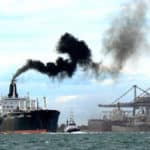Designing future-proof vessels towards net zero

Ship owners are encountering new levels of complexity as previous ship designs are modified to integrate new clean technologies and adopt alternative fuels. In this scenario, it is essential that they select a design partner who can consult effectively on the challenge and dedicate the necessary resources.
The maritime industry is undergoing a transformative shift towards decarbonization. It is clear that both, the European Union and the IMO on a global scale, are deeply committed to environmental protection, making decarbonization a top priority. The exposure to these regulations, carbon pricing, and CII ratings, will be essential commercial considerations for any ship owner or operator. They will need support in developing innovative and sustainable solutions to comply with tightening upcoming rules.
However, while much attention is given to fuel choices, decarbonization is inherently a design challenge. Whether incorporating a new fuel, adopting innovative technologies, or enhancing existing vessel performance, addressing this challenge at the design stage is crucial. Decisions made during the design phase carry long-term implications, potentially determining a ship owner’s viability over decades, given the regular lifespan of a vessel.
Hull optimization stands out as the initial step in decarbonization. Not only does it deliver efficiency benefits, but it also mitigates the high cost of future fuels. A typical cargo ship that operates 24 hours a day and 365 days a year uses about 95% of its energy for propulsion, so propulsive efficiency is going to be fundamental for shipowners looking to win commercial advantage with their decarbonization investments. The development in ship hull optimization has been rapid in recent years thanks to increased computational power available and improved software quality. A major part of today’s ship hull, appendage and propulsion optimization can be done using computational fluid dynamics (CFD) simulations in big computer clusters.

Guido Schulte
In terms of energy efficiency, there are currently alternative devices available in the market and if properly designed and optimized, these have the potential to enhance vessel performance. Even a small piece of equipment, developed using advanced modelling, can deliver a major impact on GHG emissions. To provide an example, our Elogrid tunnel thrusters can achieve a noteworthy reduction in fuel consumption and improve the vessel’s manoeuvrability by increased side thrust whilst also contributing to a substantial reduction in noise and vibration levels.
Retrofitting existing fleets is also a pragmatic approach, especially in light of the upcoming decarbonization targets. Elomatic is currently helping to evaluate clean technology solutions, as reflected by the feasibility study recently conducted for the Government of Åland in Finland to assess the viability of replacing the propulsion system of the archipelago ferry M/S Skarven, making it more efficient and reducing carbon dioxide emissions through electrification. Additionally, alternative options are being explored as part of this study, such as converting the ferry into a hybrid vessel.
Furthermore, ensuring safety throughout the design process is crucial, especially with the introduction of new fuels and technologies. With more varied fuels and technology on the horizon, more variables to simulate, and more options to test, the need for more significant, dedicated design resources becomes imperative. Simulating and analyzing ship properties and processes provides all parties with a better understanding of the possibilities of operating the ship in an energy-efficient and safe manner. The ship’s operational profile and its mission, as well as the ambient conditions of the operational area, set the boundaries of the analysis.
Future fuels will be less dense, and some will present more hazards, such as the high toxicity of ammonia. Because of this, they require more dedicated simulations for leak analysis, explosions, contamination, and other failure scenarios – especially on passenger vessels. Shipowners need a partner to scrutinize and ensure compliance in the light of current and future rules taking into consideration available and constantly maturing future technologies.
When embracing new technologies, meeting retrofitting requirements, and preparing vessels for future technologies, shipowners need partners who can provide effective consultation on the challenges and allocate the necessary resources to identify solutions.
It is therefore essential that at the design stage, a design partner can thoroughly evaluate all options, and model how they will perform. This requires significant, dedicated resources. After all, one small change at the design stage can have major impacts on operations for years to come.
Source: By Guido Schulte Managing Director Elomatic Maritime Technologies & Sales Director Marine & Offshore, Article Arranged on behalf of Hellenic Shipping News Worldwide (www.hellenicshippingnews.com)
Source link
